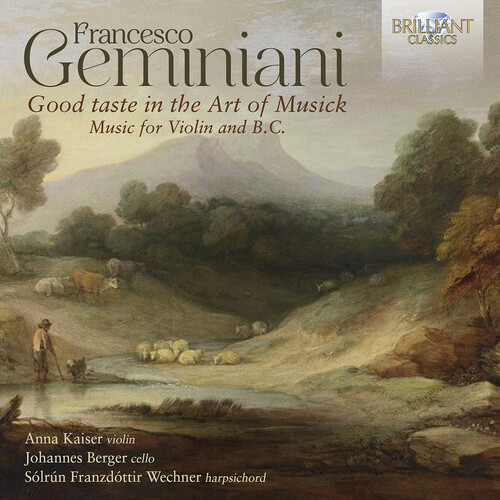Show results for
Deals
- 4K Ultra HD Sale
- Action Sale
- Alternative Rock Sale
- Anime sale
- Award Winners Sale
- Bear Family Sale
- Blu ray Sale
- Blues on Sale
- British Sale
- Classical Music Sale
- Comedy Music Sale
- Comedy Sale
- Country Sale
- Criterion Sale
- Drama Sale
- Electronic Music sale
- Golden Age of Hollywood sale
- Horror Sci fi Sale
- Kids and Family Sale
- Metal Sale
- Music Video Sale
- Musicals on Sale
- Mystery Sale
- Naxos Label Sale
- Page to Screen Sale
- Paramount Sale
- PBS on Sale
- Rap and Hip Hop Sale
- Reggae Sale
- Rock
- Rock and Pop Sale
- Rock Legends
- Soul Music Sale
- TV Sale
- Vinyl on Sale
- War Films and Westerns on Sale

Geminiani: Good Taste in the Art of Musick, Music for Violin and B.C.
- Format: CD
- Release Date: 10/10/2025

Geminiani: Good Taste in the Art of Musick, Music for Violin and B.C.
- Format: CD
- Release Date: 10/10/2025
- Composers: Francesco Geminiani
- Label: Brilliant Classics
- UPC: 5028421975870
- Item #: 2719902X
- Genre: Classical Artists
- Release Date: 10/10/2025
Product Notes
Francesco Geminiani (1687-1762), son of the violinist Giuliano Geminiani. After a season at the Teatro dei Fiorentini in Naples and a two-year spell at the Cappella Palatina in Lucca, Francesco left his homeland for good in 1714 to pursue a career in London, Dublin and Paris. The flourishing public concert life and optimal publishing conditions in London were attracting a great many Italian musicians, who were adored by the English public, achieving cult-like status - Arcangelo Corelli most of all. As a pupil of Corelli's, Geminiani inherited that legacy, while at the same time promoting an independent development in violin playing. Geminiani not only skilfully used the cult of Corelli and his own privileged position as an Italian musician to market himself; he also cultivated close contacts with powerful patrons, made a name for himself as an event organiser and painting dealer, and published several treatises.
Among those, his The Art of Playing on the Violin, which he published at his own expense in 1751, was pioneering. He was responding to a pronounced culture of violin enthusiasts, whose great demand caused a proliferation of amateur schools and rudimentary music compendiums in England. Geminiani's treatise, however, was one of the first in Europe meeting professional standards. It differs significantly in scope and conception from other treatises of the mid-18th century from German-speaking countries, focusing intently on seeking the true nature of musical expression as the highest purpose of music. This is also reflected in the term 'Ornaments of Expression' coined by Geminiani to describe ornaments. He lists a rich selection of ornaments in another method, Treatise of good taste in the Art of Musick, published in 1749, designed to help the musician practise the art of ornamentation and variation. This treatise, along with his Rules for Playing in a true Taste published in 1746, include arrangements and variations based on well-known Scots tunes. The fashion of choosing simple folk songs as the basis for compositions was also utilised by other Italian composers in order to meet the needs and preferences of the English public. Geminiani's variations uniquely combine the Italian art of variation, inspired by the example of Arcangelo Corelli, with the simple grace of Scottish folk songs and ornamentation techniques developed under the influence of many years spent in Paris. The compositions contained in Geminiani's treatises go far beyond mere didactic use. His skilful, idiosyncratic use of harmony, rhythm and ornamentation tells the story of a highly trained, experimental and unconventional artist moving between nations and compositional styles. Other information: - Recorded April 2021 in Gartensaal, Germany - Bilingual booklet in English and German contains liner notes and profiles of the musicians - Francesco Saverio Geminiani was born in Lucca. He began his study at an early age with his father, but his most important lessons followed in his years with the great Roman Master, Arcangelo Corelli. Composition lessons with Alessandro Scarlatti helped inspire and solidify his craft. In 1714 Geminiani settled in London, where he quickly gained fame as an ensemble player, concert violinist, and teacher. Here he became friends with Handel and led the orchestra during many performances together. Geminiani enjoyed great success not only in London, but also in Ireland where he spent a considerable amount of time, settling in Dublin in 1760. - Geminiani's playing was distinguished by it's great expressiveness, richness of dynamic coloring, extraordinary liveliness, and a strong temperament. Tartini called Geminiani "il furibondo" - the furious one! - One of Geminiani's most enduring legacies is his treatise The Art of Playing on the Violin, published in 1751. This influential work is one of the earliest comprehensive guides on violin technique and interpretation. Unlike previous violin tutors, which often focused on basic fingering and bowing, Geminiani's treatise provided detailed insights into expressive playing, ornamentation, and the subtleties of articulation. It reflects the evolving style of violin playing in the 18th century, emphasizing musicality over mere technical proficiency. It covers topics such as bowing techniques, left-hand positioning, and vibrato, offering exercises to develop precision and expressiveness. He also stresses the importance of dynamic contrast and phrasing, essential elements in Baroque performance practice. - Played on period instruments by Anna Kaiser (violin), Johannes Berger (cello) and Solrun Franzdottir Wechner (harpsichord).

